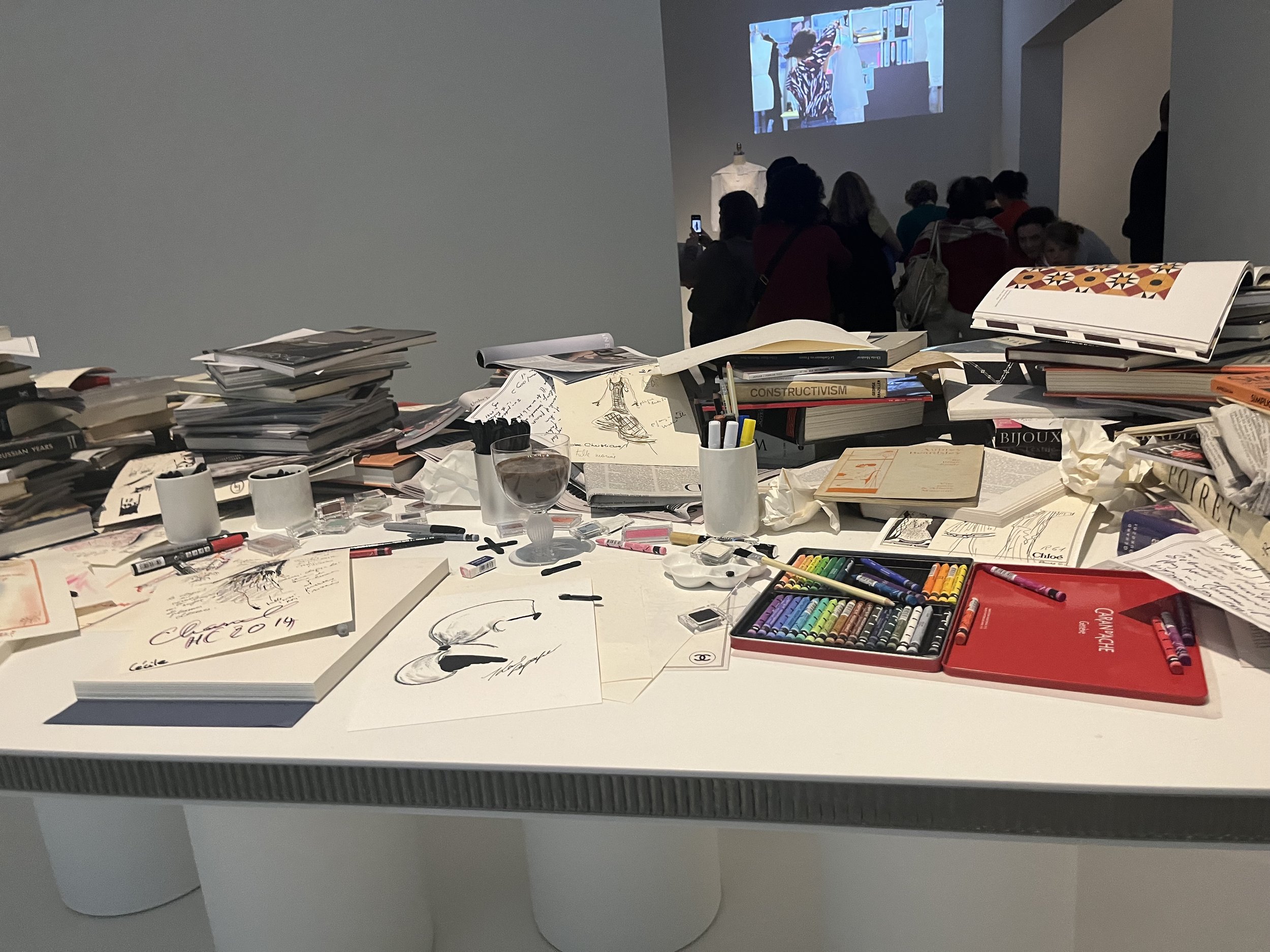Exhibition Review: Karl Lagerfeld: A Line of Beauty
The Karl Lagerfeld exhibition at The MET invites visitors on a masterful and fabulous journey through the fashion icon's renowned career. Spanning 65 years, the exhibit showcases garments from Chloé, Fendi, and Chanel, accompanied by Lagerfeld's original sketches, videos, and music. Structured as a maze, the exhibition guides guests through thematic sections highlighting Lagerfeld's signature styles, influences, and distinct eras.
Upon entering the exhibition, visitors are greeted with videos of sketches and a recreation of his bustling workspace, displaying his sketches and garments dating back to Chloé SS1967, Fendi FW1986, and Chanel SS2013. Videos featuring interviews and anecdotes from those who knew him play in the background, offering insights into his character. Tailors recall his habitual tardiness, kindness, and ability to bring his visions to life with ink and marker sketches.
Throughout the exhibit, distinct music plays, ranging from Austrian folk to La Paloma, possibly referencing the 1962 Picasso painting? While the music selections may seem mismatched, they contribute to the eclectic atmosphere of the exhibition.
The maze-like journey begins with Lagerfeld's "feminine-masculine era," which evokes Chanel's garçon style in black and white. Visitors then proceed through various sections, including the romantic era, inspired by Austrian history; the rococo and classical eras, drawing from antiquity and orientalism; and the historical and futuristic eras. Each section showcases Lagerfeld's ability to adapt and combine styles, as seen in the Chanel dress from the 2009-10 Métiers d'Art collection, which blends European drapery with a Mandarin-style collar and gold bead embroidery.
Subsequent sections feature his artisanal and mechanical designs, with separate displays for haute couture and ready-to-wear, counter-culture era, ornamental and floral geometric, figurative and abstract lines, and a satirical era reminiscent of the trompe l'oeil period.
The exhibition concludes with a tribute to Lagerfeld's iconic personal style, showcasing his black blazer, Chanel fingerless gloves, glasses, tie, fan, and Chrome Hearts collection. An adjacent room contains iPhone images of him laughing and some of his most memorable quotes.
Andrew Bolton, the curator of the Met Costume Institute, provided a comprehensive retrospective overview of the iconic creative director's 65-year career, showcasing his diverse skill set within a concise, 30-minute experience. Bolton successfully juxtaposed Lagerfeld's work's minimal and maximal aspects, earning praise from fellow museum-goers while I was there.
However, one critique lies in the exhibition's layout and flow. The gallery felt cramped and tight, which may have detracted from the experience for some visitors. A more dynamic spatial design could have been implemented to better align with Lagerfeld's vast range and creativeness. For instance, transitioning from a tight corner into a larger, more open space could have symbolized the designer's expansive influence and impact on the fashion world. Despite this minor shortcoming, the exhibition effectively presented Lagerfeld's work and legacy, offering visitors an insightful and enjoyable journey through his extraordinary career.
The Karl Lagerfeld exhibition highlighted various influential styles and techniques relevant to art history, including the garçon look and usage of trompe l'oeil.
The garçon look is characterized by masculine elements such as blouses, oversized jackets, and straight-legged trousers. This style gained popularity for allowing women greater freedom of movement and signaling their independence and professionalism. Lagerfeld's incorporation of the garçon look in his designs demonstrates his ability to reinterpret historical styles and make them relevant to contemporary audiences.
Trompe l'oeil, on the other hand, is an artistic technique that creates highly realistic optical illusions of three-dimensional space and objects on a two-dimensional surface. This technique is reminiscent of the work of designer Elsa Schiaparelli, who famously used trompe l'oeil in her designs. Lagerfeld's incorporation of this technique in his work showcases his versatility as a designer and his ability to draw inspiration from various artistic disciplines.
Throughout his tenure at Chanel, Karl Lagerfeld continued to build on this foundation by reinterpreting and modernizing the classic tweed suit, incorporating various fabrics, textures, and embellishments while maintaining the essence of Chanel's original designs.
Chanel's tweed suits were groundbreaking, as they redefined how women dressed and offered a more comfortable yet stylish alternative to the constricting garments of the era. These suits featured simple lines, blouses, and straight-legged trousers that allowed for freedom of movement and signaled a woman's independence and professionalism.
One point of reflection that this exhibition instigates is the question of how designers can balance the preservation of a fashion house's heritage with the need for continuous innovation and evolution. How can the fashion industry maintain its connection to the past while also pushing the boundaries of what is possible in the present? As showcased in this exhibition, Lagerfeld's work serves as a testament to that. I found that everything derived from something, and even if a design seemed nuanced, history inspired it. Is this a bad thing? No, but it is something to ponder and investigate in fashion history. Is it just an ever-evolving trend cycle that gets refurbished over time? The point of reflection for me is the adage; no ideas are new. We take a lot of old ideas and put them into a sort of mental kaleidoscope. We give them a turn, and they make new and curious combinations; I believe that is a Mark Twain quote.
In conclusion, the Karl Lagerfeld: A Line of Beuty exhibition at The MET explores the legendary designer's 65-year career. The exhibition highlights Lagerfeld's ability to balance tradition with innovation, reinterpreting historical styles for modern audiences. Despite minor layout shortcomings, the exhibit serves as a thought-provoking reflection on the cyclical nature of fashion and the importance of heritage in shaping its future, leaving visitors with a deeper appreciation for Lagerfeld's work and the fashion world's evolving relationship with its past.






